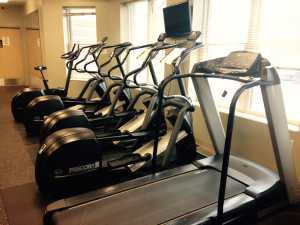
03 Feb Study Evaluates High vs Low Intensity Exercise for Knee Arthritis
MedicalResearch.com Interview with:
 Tom Arild Torstensen
Tom Arild Torstensen
Department of Neurobiology, Care Sciences and Society
Division of Physiotherapy,
Karolinska Institutet, Huddinge, Sweden and
Holten Institute, Stockholm, Sweden
MedicalResearch.com: What is the background for this study?
Response: People suffering from pain due to knee osteoarthritis (OA) is a major and increasing problem. There there is today good scientific evidence for different forms of exercise therapy, but there is no agreement regarding what type of exercises and what dose of exercise therapy is best. Thus, we wanted to investigate if high dose medical exercise therapy is superior to low dose.
MedicalResearch.com: What are the main findings?
Response: The main findings from this superiority study do not support our hypothesis that high-dose exercise is superior to low-dose exercise. The only differences favoring high-dose exercise were in the domain of knee function during sports and recreation at the end of treatment and 6 months after the intervention and in the QoL domain at 6 months. Notably, most variables numerically favored the high-dose group, albeit not in a statistically or clinically meaningful way. Adherence was nearly perfect in the low-dose exercise group but was lower in the high-dose exercise group. No adverse events were reported.
MedicalResearch.com: What should readers take away from your report?
Response: Our study was designed as a superior trial, meaning that even though we failed to show that high-dose treatment is better than low-dose treatment, our results do not imply that a low-dose exercise regimen is as beneficial as a high-dose regimen. Interestingly, it seems that high-dose treatment could be preferable to low-dose treatment in the long run for people who lead active lives. This should be the subject of future studies.
In the discussion we refer to positive and negative expectations (placebo/nocebo) in relation to pain as a homeostatic feeling (1 and 2) and that those mechanisms might have overrided the physiological effects of the difference in exercise dose during the 12 week intervention period. These mechanisms are surely present in our study because all patients in both high-dose and low-dose were supervised during the treatment by experienced physiotherapists. The basis for medical exercise therapy is close supervision using graded exercise therapy as a form of cognitive behavioral therapy applying methods like exposure and acceptance. It might be that the feeling state of pain is the game changer and when a person is experiencing pain and seeking help from a health professional the most important factor for a decrease in symptoms are the positive experience of being helped by the physiotherapist.
MedicalResearch.com: What recommendations do you have for future research as a results of this study?
Response: I believe we have to update our understanding of pain as a homeostatic emotion (1 and 2). That anxiety and pain are similar entities and the importance of health professionals being present with the patient supporting – communicating – with the patient during the treatment phase is fundamental for achieving a positive outcome. I also think we need to take a step back and do more RCTs having a comparison group with a minimal type of treatment but still getting the attention from the therapist exploring how important positive expectations (placebo) and negative expectations (nocebo) really are. As human beings we are social animals depending on each other, seeking help when we are not able to solve the problem ourselves. Thus we should stop looking at placebo as something negative. Instead we should look at positive expectations (placebo) and negative expectations (nocebo) as thoughts and feelings that makes us human. All the time we are thinking this is good or that is bad. And finally, when I treat a patient and designing an exercise program I am the exercises. The exercises are an extension of me, my personality, my thoughts and feeling, that I through the exercise give to the patient to help the patient.
Citations:
High- Versus Low-Dose Exercise Therapy for Knee Osteoarthritis: A Randomized Controlled Multicenter Trial. Ann Intern Med. [Epub 24 January 2023]. doi:10.7326/M22-2348
2) Larkin H. Both High- and Low-Dose Exercise Therapy Help Knee Osteoarthritis. JAMA. Published online February 01, 2023. doi:10.1001/jama.2023.0746
https://jamanetwork.com/journals/jama/fullarticle/2801204
3) Craig AD. A new view of pain as a homeostatic emotion. Trends Neurosci 2003;26:303–7.
4) Ingvar M. Learning mechanisms in pain chronification – teachings from placebo research. Pain 2015;156:S18–S23
“The seminal article of Craig with the description of pain as a homoeostatic emotion moved the field away from the concept of a “searching for pain center” in the brain to a systems-oriented understanding. The experience of pain was put in a behavioural perspective and the dynamics of the preprogrammed complex emotional reactions to acute pain were explained in terms of a dynamic regulatory system. Just as in all other expressions of emotion, the homoeostasis model for understanding pain provides both a basis for a prolongation of the feeling state but also, at the same time, an effective measure of social communication to alert others of, eg, danger. In addition, such a mechanism also serves to raise empathic responses in the group. The understanding of pain as a homoeostatic emotion has also contributed to the understanding of affective comorbidity in different pain syndromes because the mechanisms of both lowered mood and anxiety are based on similar regulatory mechanisms. However, the mentioned mechanisms are mostly represented in the phylogenetically old components of the central nervous system. The role of the cerebral cortical regulation in chronic pain remains a challenge to fully explain”, Ingvar M (2015) pp:S18, line 13-31
The information on MedicalResearch.com is provided for educational purposes only, and is in no way intended to diagnose, cure, or treat any medical or other condition. Always seek the advice of your physician or other qualified health and ask your doctor any questions you may have regarding a medical condition. In addition to all other limitations and disclaimers in this agreement, service provider and its third party providers disclaim any liability or loss in connection with the content provided on this website.
Last Updated on February 3, 2023 by Marie Benz MD FAAD
